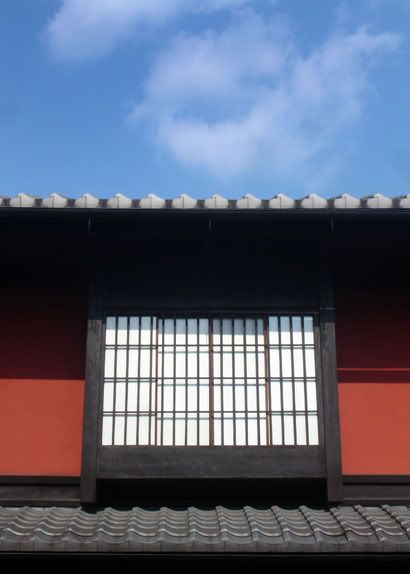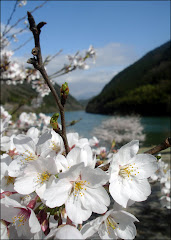Friday, September 30, 2005
Home of the Gods
Thursday, September 29, 2005
On Earth As It Is In Heaven

The legendary origins of Angkor Wat (or Capital Temple), according to locals, lie in the story of Preah Ket Melea, son of the king of heaven and a mortal woman. The gods complained that he smelled, and asked his father to send him down to Earth. The king agreed, offering his son the opportunity to have an exact replica of any edifice in heaven erected on Earth with the help of the celestial architect (whom villagers still invoke whenever a building is constructed). A modest man, Preah Ket Melea chose the stable. An ox was released onto the plain of Angkor and the place where it layed down became Heaven on Earth: Angkor Wat.
Wednesday, September 28, 2005
Sunrise Over Angkor Wat
 My second day in Cambodia began at 5:30 AM as I jumped from my bed to catch a bus to one of the seven wonders of the world. Charmed by the chanting of the monks nearby, the sun slowly rose out of the darkness, above the five peaks representing Mount Meru, the center of the Hindu universe and home of its gods. I'm back. Hope all of you waiting won't be too disappointed.
My second day in Cambodia began at 5:30 AM as I jumped from my bed to catch a bus to one of the seven wonders of the world. Charmed by the chanting of the monks nearby, the sun slowly rose out of the darkness, above the five peaks representing Mount Meru, the center of the Hindu universe and home of its gods. I'm back. Hope all of you waiting won't be too disappointed.Thursday, September 15, 2005
The Bread-Head Incredibles
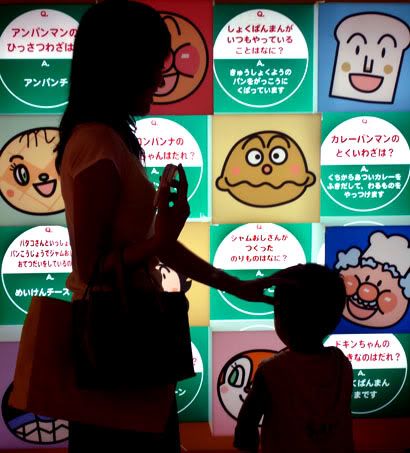
Anpanman is not alone in Anpan Land! The Bread-head incredibles are always saving the day with their special super-pan powers! Where as Anpanman`s bun is bursting with sweet bean filling, Currypanman`s cranium is crammed with curry (center of the photo). Shokupanman, a slice of white bread, has no delicous filling, but he makes up for it with his dashing good looks (upper right). Shokupanman is Anpanman's closest and most handsome superhero friend. Patron super-snack of school lunches, he is the resident gaijin of Anpan Land, complete with the gaijin powers many foreign men recieve upon entry in Japan. He`s quite a hit with the ladies! Suprisingly enough, Shokupanman's secret headquarters lie deep within Toaster Mountain.
Wednesday, September 14, 2005
Anpan Man Begins...
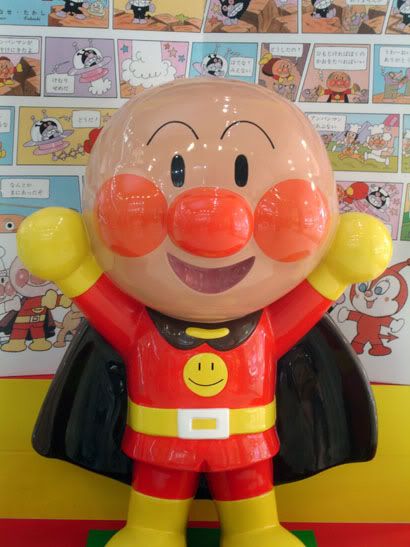
Anpan (あんパン) is a Japanese bread (or pan, as it was introduced to Japan by the Portuguese,) filled with sweet, red bean paste- the secret to Anpanman's super-snack strength!
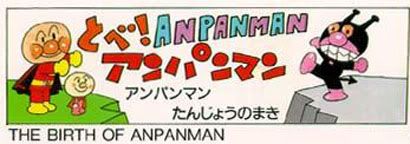

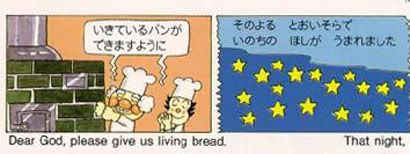
Dear God, please give us living bread...That night....


....The bread is baked!.........Waaaaah!


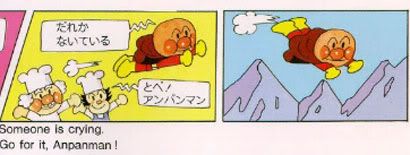
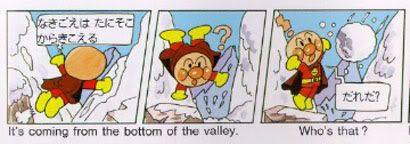



"Yummy Woof! "...."Let's call you cheese!"
The Original Anpanman Cast:
Uncle Jam, the kindly old baker who made and raised Anpanman, and replenishes his sweet-bean strength.
Batako, Uncle Jam's young, female assistant.
Cheese, their adopted puppy.
Anpanman, the super-hero snack man fighting hunger with his delicious sweet-bean filling.
Baikinman, a dirty germ, and arch-enemy of anpanman.
Monday, September 12, 2005
Modern Maiko

A maiko checks in with her Okiya on her ketai, or mobile phone, as she strolls Shijo-dori with her Yakuza-looking patron during Gion Matsuri's Yoiyama. A few geiko followed behind. (The Yakuza is like the Japanese mafia).
Sunday, September 11, 2005
Tono Crew Conquers Mount Ena
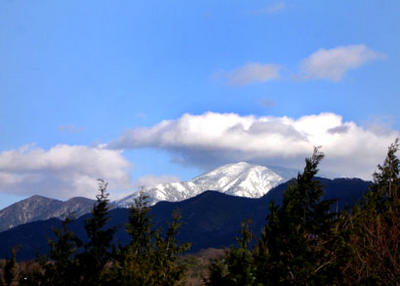 At 2190 meters, Mount Ena is listed as one of the top 100 hikes in Japan. (The view from near my apartment last spring).
At 2190 meters, Mount Ena is listed as one of the top 100 hikes in Japan. (The view from near my apartment last spring).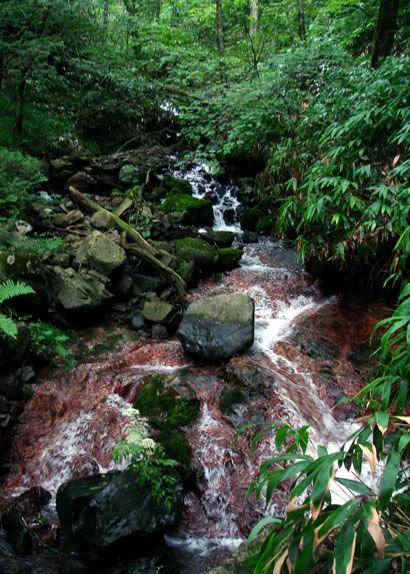
Following the Nakatsugawa river back to its source...
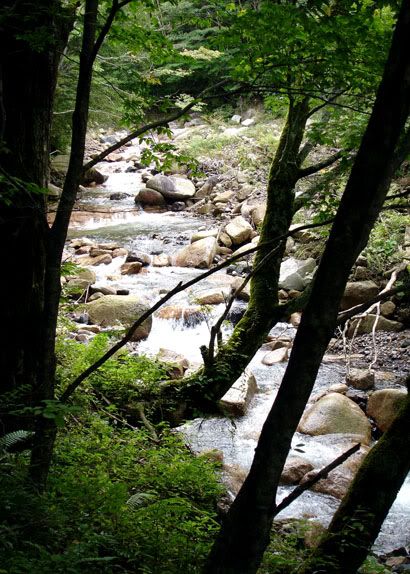
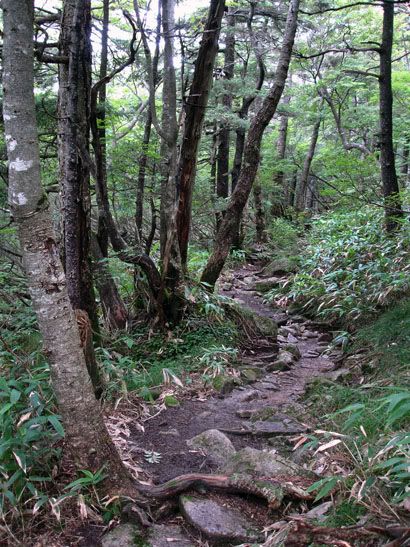
The narrow trail winds its way through thick, green vegetation.

What trail, you ask?

Just follow the slippery, moss covered rocks uphill for, oh, let's say 2,189 meters!
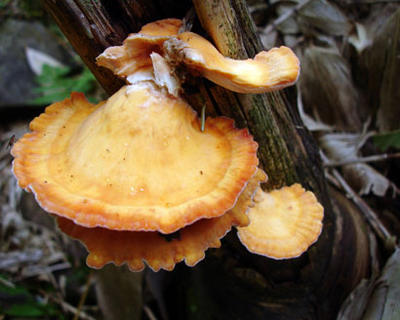 Along the way, don't forget to stop and smell the fungi!
Along the way, don't forget to stop and smell the fungi!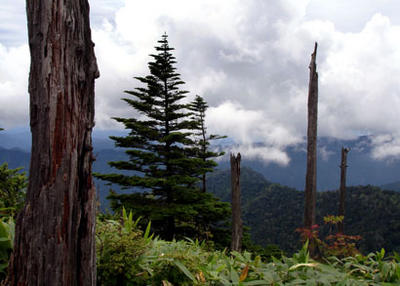


The view from the summit, after 3 and 1/2 hours of hardcore hiking. Somewhere, tucked beneath the folds of those mountains, is my home.

J looks remarkably excited about the prospect of sliding down Ena on his oshiri as he slips over the edge.
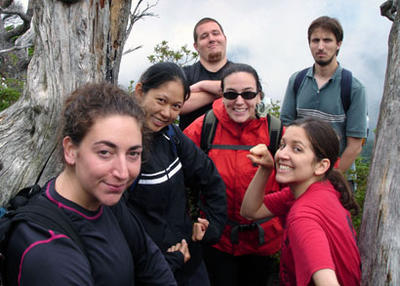 The tough kids who climbed Mount Ena, and lived to tell the tale.
The tough kids who climbed Mount Ena, and lived to tell the tale.
Thursday, September 08, 2005
A Walk in the Rice
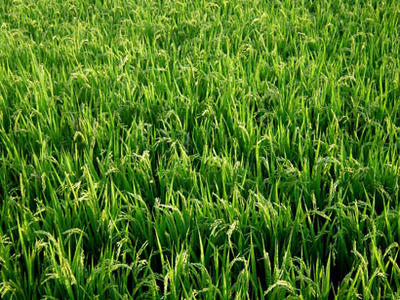 Ena's emerald waves of grain cover the foot of the mountains like an old, patchwork quilt from Gee’s bend.
Ena's emerald waves of grain cover the foot of the mountains like an old, patchwork quilt from Gee’s bend.A friend, who shall remain nameless, requested that I take a few pictures of my surroundings (obviously he does not appreciate my obsession with Geisha). Since I've had Kuruma-chan (my beloved car), my rice feild wanderings have significantly decreased, which is an absolute travesty! I decided to rectify the situation by reaquainting myself with the country side through which I so often meandered when I first arrived in Ena.
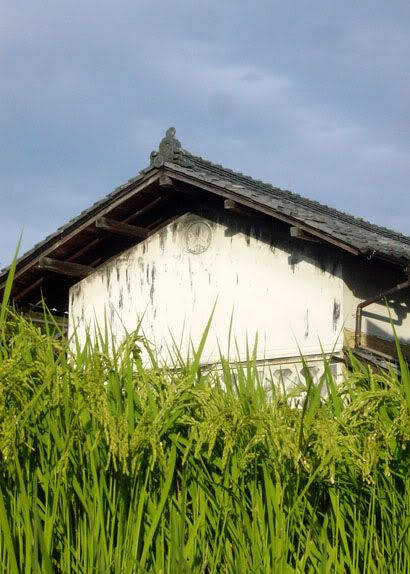
Ena's countryside is dotted with Edo period store houses, built separate from the main house to protect family heirlooms and valuables from fire.
Back at home in the states, I remember smelling winter on the autumn winds, shuddering with the brightly colored leaves. In Japan, it is the mouth-watering aroma of autumn, wafting from rice field to rice field that I look forward to during the long summer months. Imagine the sweet smell of popcorn mingled with the fresh scent of summer rain and the smoke of a campfire; the sound of water flowing down from the mountains into moats encircling each emerald patch; pine covered mountains, rising like islands from the steady waves of wind-blown rice; dragonflies hovering over swaying stalks, heavy with the year's harvest, as butterflies dance to the chorus of chirping insects and burping frogs. As autumn draws near, the smell of the rice begins to hang so thick in the air you can almost taste it. 美味しそう!
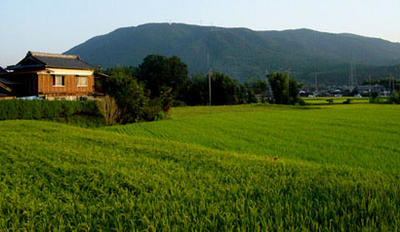
Tuesday, September 06, 2005
Memoirs of a Geisha: Gion, Hollywood Style

Watch the Memoirs of Geisha trailor by clicking here!
I have quite a bit to say about this movie...I'll write about it tomorrow! In the meantime, you can compare what you've seen here to what you will see in a theatre near you soon!
Sunday, September 04, 2005
The Girls of Gion
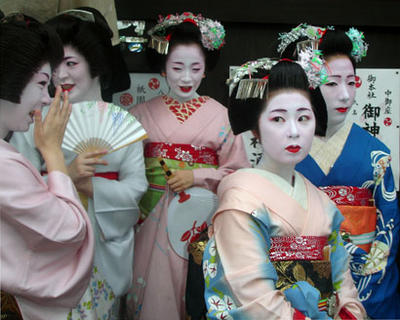 A crew of Geiko and Maiko gathered outside the famous noren of the Ichirikiya to cheer the men on as they carried portable shrines down the Hanamikoji (Gion Matsuri).
A crew of Geiko and Maiko gathered outside the famous noren of the Ichirikiya to cheer the men on as they carried portable shrines down the Hanamikoji (Gion Matsuri).Thursday, September 01, 2005
Samurai-Style: The 47 Ronin
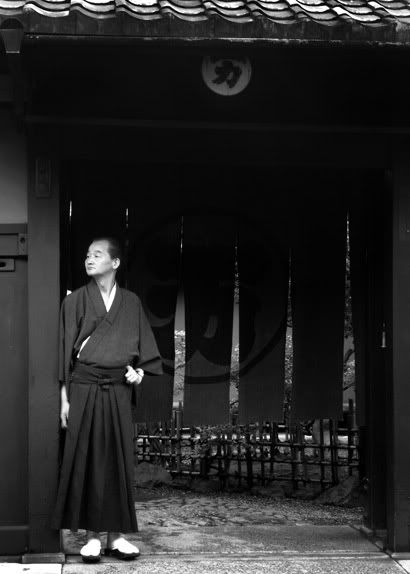
Behind the gate of the Ichirikiya, the world of old Japan lives on.
The fame of the Ichirikiya,
The story of the 47 Ronin is one of the most celebrated in the history of the samurai. This was perhaps all the more so because it occurred at a time when the samurai class was struggling to maintain a sense of it’s self - warriors with no war, a social class without a function. Over time, the story became a symbol of loyalty to one's master, and later (especially during WWII), of loyalty to the Emperor.
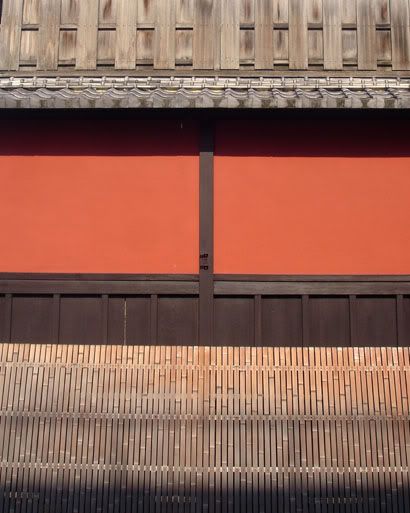
The bright red walls of the Ichirikiya, which concealed the leader of the 47 ronin.
The fateful series of events began to unfold in 1701, when the young daimyo of Ako was instructed to receive the emperor's envoys as they paid respect to the Shogunate. In order to properly perform this duty, he was placed under the tutelage of a corrupt, yet powerful, official in the hierarchy of the Tokugawa Shogunate: Kira Kouzukenosuke. Angry that Ako ha not seen fit to offer a bribe for his services, Kira verbally abused Ako, insulting and humiliating him in public while refusing to teach him proper court protocols. Finally during a meeting at
Kira's survived, but the attack on a shogun official within the
Kira, however, was no fool, and expecting retaliation from Ako's samurai, fortified his residence under heavy guard. To quell the suspicions of the Shugunate and Kira, the 47 ronin spilt up and became tradesmen, monks, and in Oishi's case (their leader), playboys. He moved to 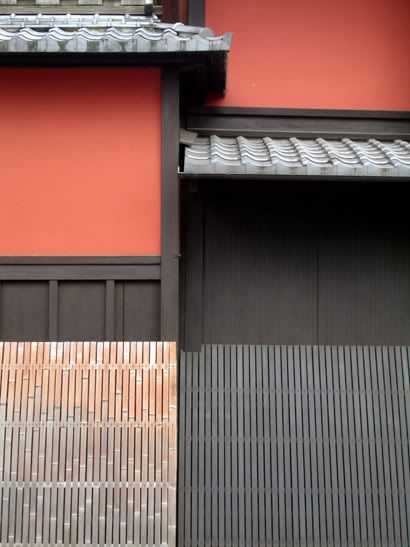
Drunk and stumbling home one night, Oishi fell down in the street and passed out. Onlookers laughed, and one Satsuma man, so infuriated by his 'conduct unbecoming of a samurai insulted him for his lack of courage in failing to avenge his master's death, kicked him in the face and spat on him (to even touch the face of a samurai was a great insult, let alone kick it). Soon after, concerned that her husband was taking the act too far, his faithful wife of 20 years questioned his behavior. He divorced her on the spot and bought a beautiful concubine to take her place
When word of this reached Kira, he became convinced that he was no longer in danger. When he began to relax his guard, the rest of the ronin gathered in
When the necessary preparations were made and Oishi was convinced that they could catch Kira off his guard, he fled 
At their last supper, the men had agreed that they would cut off Kira's head and offer it at the tomb of their master before turning themselves in to face their deaths. Oishi also asked that they take care to spare the women, children and helpless people in the attack. After breaking thru the guard at the Kira's gate, he even sent messengers to the neighboring houses, explaining that they had not come as thieves but as retainers out to revenge the death of their master, promising bring them no harm. In their hatred for Kira, the neighbors did nothing
After a fierce battle with Kira's men, Kira himself was no where to be found. Oishi checked his bed, the warmth of which promised he could not be far. In their search they discovered the entrance to a secret courtyard hid behind a large scroll. Hiding in a storage building they found a man who refused to disclose his identity. Under the light of a lantern the scar on his head from Ako's attack betrayed him, making it clear to the men that it was indeed Kira .
In a show of respect for Kira's high rank, Oishi got down on his knees and respectfully addressed him, announcing that they were retainers of Asano, come to fulfil their duty by avenge his death. Handing Kira the same dagger Ako had committed Seppuku with, he invited Kira to die as a true samurai, taking his own life. He even offered to act as a second (as portrayed in Algren's first encounter with 'The Last Samurai', when he cuts off the head of his friend after he commits seppuku), but Kira was speechless, trembling with fear. Finally Ōishi ordered the others to hold him down as he cut off his head with Ako's dagger. Extinguishing the lamps and fires in the house (lest any cause the house to catch fire, and start a general fire that would harm the neighbours), they sent out for the grave of their master, carrying Kira's bloody head, while the youngest ronin was ordered to travel to Akō and inform them that their revenge had been completed. Along the way they were praised by the common people for their courage.
At the temple, they cleaned Kira's head in a well, laying it and Ako's dagger before his tomb. After praying, they left all their money to the abbot, asking for a proper burial before turning themselves in.
Although the ronin had followed the precepts of bushido (the way of the warrior) by avenging their lord, they had also undermined the authority of the shogunate, which had forbidden their revenge. On Febuary 4, 1703, the shogunate graciously allowed the 46 men to commit Seppuku rather than be executed as criminal. A truly happy ending, by Japanese standards.
The forty-seventh ronin eventually returned from his mission, and was pardoned by the Shogun, perhaps because of his youth. He lived to be seventy-eight, and was then buried with his comrades and his lord at Sengakuji. The clothes and arms they wore are still preserved in the temple to this day, along with the drum and whistle used in the attack. (Their armor had been home in order not to arouse suspicion by buying it).
The tombs became a place of great veneration, and people flocked there to pray. One of those who came was a Satsuma man, the same one who had mocked and spat on Ōishi as he lay drunk in the street. Addressing the grave, he begged for forgiveness for his actions, and for thinking that Ōishi was not a true samurai. He then committed seppuku, and was buried next to the graves of the ronin, who many feel were the finest examples of samurai loyalty to emerge from the Edo Period.
